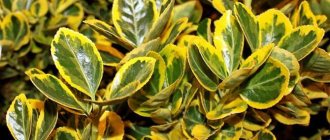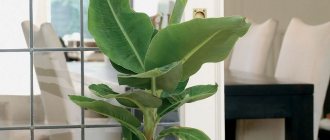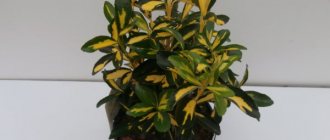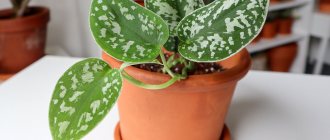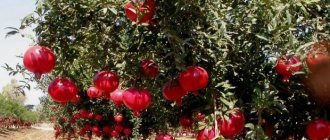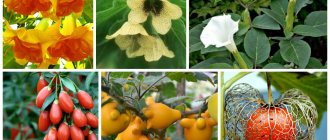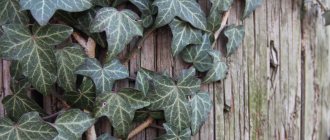What does an indoor banana look like, what family does it belong to?
Southeast Asia is considered the birthplace of the banana. In nature, the height of the trunk reaches 12 meters. Of course, such a giant is not suitable for a home. Therefore, dwarf varieties up to 2 meters high are placed in the apartment. This raises the question: is a banana palm a tree or a grass?
Dwarf varieties
Note! The indoor banana is not a tree or shrub. This is a perennial herb. The fruit is a berry, and not a fruit at all.
Features of the plant:
- height 1.5-2 meters;
- leaves up to 2 meters in full length, with a width of up to 50 centimeters;
- the trunk of the plant is formed by densely superimposing the base of the leaves on top of each other and is a pseudostem;
- the trunk simultaneously acts as a root system and is located underground;
- indoor banana produces a flower from a pseudostem that dies immediately after fruiting.
The tree lives for about 5-6 years.
The berry is widely used in medicine. It is used for cholelithiasis, diseases of the liver and gastrointestinal tract. It has an enveloping effect, which is useful for stomach and duodenal ulcers in case of exacerbation. Fiber helps improve digestion. The potassium contained in the fruits has a beneficial effect on the functioning of the heart.
Important! Scientists note that people who eat bananas have a more optimistic outlook on life.
Initially, bananas grew only in the tropics. At the beginning of the 15th century, they were brought to Europe from Africa by Portuguese sailors. Having begun to propagate them in the Canary Islands, they gradually developed cold-resistant varieties that have spread throughout the world. Since the 16th century, bananas have become popular in the Caribbean and Central America.
Features of caring for indoor bananas at home
Banana palm, what trees do bananas grow on?
At home, fruits grow only if you carefully care for the plant.
Temperature
The tropical native loves the heat. High temperature is vital for it - it should be above room temperature - 25-30 °C, without falling below 15 °C. Low temperatures slow growth and promote disease.
Considering that this is a southern plant, it needs a lot of sun. When caring for indoor bananas at home, windows on the south or east side are suitable. On cloudy days and in winter, backlighting is required. The quality of lighting is directly related to the growth of green mass. In poor lighting, grass growth slows down, fruits stop setting, that is, it will not bear fruit.
Additional lighting
Watering and humidity
It is recommended to water infrequently, but abundantly, to wet all the soil. The indicator is the drying of the top crust of the earth by 1-2 centimeters. If water is taken from the tap, be sure to let it sit for the chlorine to evaporate. Sometimes, instead of watering, you can organize a warm shower, as in the tropics.
Leaves are sprayed daily in summer. In winter, once a week is enough.
The plant is recommended to have a humidity of over 65%. It is difficult to organize at home, so daily wet wiping of the leaves is necessary. High humidity and sun are the main components of successful cultivation.
Priming
The soil requires periodic loosening to allow air to reach the roots and destroy the soil crust. The top layer of soil taken from linden, hazel, birch or acacia is suitable. By adding sand, wood ash and humus, the composition is mixed and calcined. Drainage, sand and then soil are laid out at the bottom of the dish. The soil should be loose, with a neutral PH.
Top dressing
Needs to be fed regularly. Organic substances - vermicompost or herbal infusion - are suitable for this. Organics are supplemented with universal mineral fertilizers. The plant being fed needs to be darkened for a day.
Solving possible problems
There are several factors that prevent a banana tree from growing. Due to lack of sunlight or cramped containers, it stops growing. The problem is solved by replanting the crop and choosing a suitable window sill.
Leaf blades withered along the edges indicate low humidity levels. This crop is often sprayed using a spray bottle. On the other hand, due to excessive humidity, black-brown spots appear on the leaves and the roots begin to rot. Transplanting a crop will save it from imminent death.
As you can see, growing a banana tree at home is a labor-intensive process. First, seeds are purchased and germinated using special technology. The seedlings are transferred to larger containers. The rooted exotic is watered abundantly, regularly fed and sprayed with warm water. The result is a gorgeous crop with magnificent flowers and edible fruits.
How to grow in open ground, where and under what conditions is this possible?
How to grow banana at home
Not all types of domestic bananas can tolerate low temperatures in open ground. For example, heat-loving Ecuadorian species will definitely not grow here. But adapted cold-resistant species can be grown in the subtropics. In our country this is the region of Sochi and Crimea.
Banana palm Basio - its planting and care in open ground is typical throughout Japan and the Black Sea region. European gardeners also take advantage of its cold resistance by growing it on the shores of the Mediterranean Sea. During frosts and subzero temperatures, the plant is additionally insulated. The ground around the root should not freeze.
Palma Basio bloomed in Crimea
How to grow a banana tree at home
The first step towards the goal is high-quality planting material. It is bought in stores or obtained from wild bananas, which are sometimes sold in supermarkets. They are small in size. Inside the pulp are “precious” black seeds.
For growing a banana tree at home, fruits with perfect peel are suitable.
The purchased exotic raw materials are placed in a plastic bag and tightly closed to block the access of oxygen. When the peel darkens, carefully remove it. The pulp is cut in half, the seeds are removed with a sharp knife and laid out on paper. Flat specimens are removed, leaving only round grains.
The following is a simple diagram:
- planting material is thoroughly washed;
- put in a glass container;
- fill with clean water;
- leave for 3 days.
After the expiration date, the seeds are washed again and laid out on paper to dry. Prepare a substrate from coconut or sphagnum. Most often it is bought in flower shops. Warm up under steam before use. When it cools down, mix with perlite and then water with potassium permanganate. If desired, you can prepare the soil yourself from coarse sand and peat (1:3). Next, we’ll look at how to properly plant a banana at home to decorate the interior or produce tasty fruits.
It is advisable to purchase seedlings of fruiting varieties of banana trees at specialized retail outlets.
Landing technology
Since the shell of banana tree seeds has a dense structure, it is gently rubbed with sandpaper or a manicure file. Thanks to this, they will germinate faster. Then they are lowered into the prepared substrate. When the sprouts appear after 2-3 months, they begin to plant bananas at home using this technology.
First, prepare suitable soil. The top layer of soil (about 7 cm) is taken from under a birch, linden, hazel or acacia tree.
Add to it:
- sand (1:10);
- wood ash (1:0.5);
- humus (1:2).
The thoroughly mixed mixture is placed in a preheated oven at 55°C for 10 minutes. Then drainage is poured into the bottom of the pot. On top of it is moistened sand and heated soil. The sprouted grain is buried about 2 cm. Gently sprinkled with earth and moistened generously. The rooted culture is transplanted into a container with a large volume and a beautiful design.
For the first planting of a banana tree seedling, it is advisable to use a small container.
When and how does it bloom
With good care, an indoor banana tree will bloom in its third year of life. Already in the middle of summer it can throw out an arrow among the leaves in the form of an umbrella. By this time, the plant should have 16-17 leaves. From the heart-shaped upper leaf emerges a large panicle of inflorescence with green or brownish flowers. As flowering progresses, the panicle enlarges and hangs down. The growth of the panicle can last up to 2-3 months.
Hamedorea palm - home care
Indoor banana flowers come in different sexes. Pollination of females produces “banchu,” a cluster of bean-like fruits. Over time, the leaves fall off.
Important! During the flowering and fruiting period, it is necessary to feed with nitrogen and phosphorus fertilizers.
Botanical description and varieties
Before we look at what a banana tree looks like from the outside, let's note that it is, in fact, grass. In its natural environment it has a powerful rhizome. A stem emerges from it, reaching 20 m in height and about 40 cm in diameter. Giant leaf plates grow around it, about 2 m long. The maximum width reaches 1 m.
Depending on the variety, they are:
- plain;
- speckled;
- two-color.
Flowering lasts approximately 8 or 10 months. At this time, a powerful peduncle, colored dark purple, forms among the lush greenery. It is surrounded on all sides by pretty buds that turn into exquisite fruits. This is what culture looks like in nature.
A banana tree grown at home is relatively small in size. The height of the crop does not exceed 2 m. The length of the plates is approximately 1.5 m, the width is no more than 30 cm. At the base, the leaves are very close to each other, forming an imaginary trunk. The real part of the stem is hidden under the substrate. It is also the rhizome of the banana tree. An inflorescence with many buds grows from its center. After fruiting it dries completely.
Decorative varieties are used to create a stylish interior.:
- Lavender;
- Velvety;
- Bright red;
- Chinese dwarf.
The pointed banana, Kiev superdwarf or dwarf Cavendish are grown as fruit crops. However, the whole process requires special effort and patience from the grower. The reward will be exotic yellow fruits with a delicate taste or lush tropical greens.
Since the indoor exotic is able to overcome a height of 2 m, it is advisable to place it in the appropriate apartment.
How to propagate indoor banana
Dwarf bananas are usually propagated by seeds, propagules, or vegetative methods. Each of them has its own characteristics.
Seeds
If you wish, you can get the seeds yourself:
- wrap the yellow banana in plastic wrap until the peel completely darkens and the fruit softens;
- peel the fruit and cut lengthwise without touching the core;
- remove the seeds and place them on paper or a napkin;
- select full seeds and discard flat ones;
- rinse the seeds to remove pulp;
- fill with water for 2-3 days;
- rinse again and dry well.
Attention! A plant grown from seeds is completely decorative - the fruits are not suitable for food. With this method it will be possible to raise only wild animals. But uncultivated grass will be stronger and more resistant to disease.
The seeds are germinated in sphagnum moss or coconut fiber. This material is purchased in special stores, after which it is steamed, mixed with perlite, and spilled with a weak solution of potassium permanganate. An alternative is a mixture of peat and sand in a ratio of 3/1.
For germination, drainage material is placed in the container, with a substrate on top, 5-6 cm thick. The seed coat is broken by scratching or sawing. The container must be covered with polyethylene to create a greenhouse effect. Daytime temperatures can reach 33 °C, night temperatures can reach 20-25 °C. Germination is a long procedure, up to 2-3 months.
Children
Varietal indoor banana plants are grown only from root shoots, dividing the rhizome into parts. With such propagation, all the qualities of the mother plant are preserved.
Reproduction from root shoots
Vegetatively
Cultivated varieties also reproduce vegetatively from an adult plant. This can speed up the ripening process, and as a result, the fruits will grow in just 2 years.
How does a banana reproduce?
Banana can reproduce in three ways:
- Seed method. The plant germinates from seeds. This is the most difficult method, since the banana seed has a hard skin, through which it is difficult for the sprout to hatch.
- Division. Produced during plant transshipment. A piece with a shoot is cut from the rhizome with a sharp knife. It is treated with crushed charcoal and planted in a separate pot.
- Reproduction by shoots. It can be produced if there is a shoot that has several leaves. This stem is cut off, sprinkled with coal and planted in a separate flowerpot.
How to grow mangoes from seeds at home
It is more convenient to grow new plants from shoots or by dividing part of the root. These processes occur painlessly for an adult banana, and young plants take root and develop faster.
Growing banana from seeds at home
For tourists traveling to Thailand, China, India and other Asian countries, there is the opportunity to encounter mini bananas with seeds. These seeds can be used to grow this plant at home.
Before planting, the seeds are soaked for 1 month. This period is necessary to soften their dense shell. After soaking, the shell must be filed off with a nail file or sandpaper. Then the seeds are planted in well-moistened soil, they are buried.
The top of the container is covered with glass or transparent film.
Important! To germinate seeds, you will need a temperature of at least +30°C, constant moisture and ventilation of the soil.
The first shoots appear after 70-80 days. Young seedlings are assigned to a permanent place of residence.
How to get seeds from a store-bought banana and germinate them
To get seeds from a purchased banana you need:
- Choose a large ripe banana.
- Place it in a plastic bag and wait for the skin to completely darken.
- Peel the fruit and cut it lengthwise into two equal parts.
- Remove the seeds from the pulp with a sharp object and spread them on a paper napkin.
- Try to find round seeds, keep them, and discard the rest.
- Rinse the seeds well to completely separate the pulp.
- Fill the future planting material with warm water and put it in a warm place for 2-3 days.
- Rinse thoroughly and dry.
After this, the seeds are laid out in a neutral substrate for germination. This could be sphagnum or coconut, which can be purchased at a flower shop. Seeds can germinate up to 3 months.
For reference! The option of growing bananas from seeds in Russia is close to zero. Bananas are brought in practically without them, and those that are available often turn out to be unviable.
Preparing store-bought banana seeds
Transplantation: when is it necessary, how to do it correctly
When purchasing a seedling in a store, or growing it yourself, you need to pay attention to the need to replant the grass as it grows and the root system increases. In the store, plants are sold in tiny pots, so they need to be replanted within a week. In this case, you should inspect the roots and stem for the presence of pests and insect larvae.
Under favorable conditions, up to several transplants per year may be required. An indicator for replanting will be roots protruding above the ground. When planting in a new pot, it is necessary to ensure good drainage - stagnation of water can destroy the roots.
Additional Information ! The size of the pot, as it grows, changes from 2 to 50 liters. Drainage should occupy about a third of the container. Do not replant immediately into a large pot - insufficient filling of the root system will cause acidification of the soil.
The next container for transplantation should be 3-4 centimeters larger than the previous one. When replanting a banana, it is necessary to deepen it to form adventitious roots. Mature plants require renewal of the top layer of soil. It is better to replant the plant using the transshipment method in order to avoid damage to the root system.
Possible problems in growing indoor bananas
Considering the exotic nature of the plant and its unadaptability to our conditions, characteristic problems arise.
Leaves wither
Here are some of them:
- The grass is shedding its leaves. This is usually due to a lack of nutrients. It is necessary to carry out scheduled and unscheduled fertilizing, and then change the pot to a larger one.
- The tips of the leaves begin to dry out. This is due to low humidity. It is necessary to increase the frequency of spraying and wet wiping of leaves. If necessary, increase the total humidity of the room. To do this, install a humidifier or place an open container of water nearby.
- The lower leaves fall off. This is usually due to hypothermia or being in a draft. It is recommended to move away from the cold window or increase the temperature.
- The appearance of pests. Often affected by spider mites and thrips. When they appear, the leaves are treated with an insecticide.
Palm tree in the garden of a private house
- Mucous rot of the stem indicates waterlogging during the cold period. To combat this phenomenon, it is necessary to reduce watering, remove rotten parts of the grass, and treat the plant with a fungicide.
- Small and pale foliage indicates a lack of lighting. This usually happens in winter. This can be corrected by placing the plant in a sunnier area or increasing artificial lighting.
- No growth in spring. The grass does not have enough nutrition, so additional feeding is necessary.
- The bottom of the stem darkens and becomes soft. This is a serious sign of plant disease. Overmoistening of the soil and stagnation of water leads to rotting of the base of the stem.
Growing an indoor banana is a very troublesome task. However, the banana tree is a house plant. Your efforts will be rewarded by the surprise of your friends and acquaintances with such an exotic object. In the Black Sea regions, cold-resistant varieties can be placed directly on the street so that they delight not only their owner, but also those around them.
It is enough to grow this crop yourself to understand that banana is a home plant.


